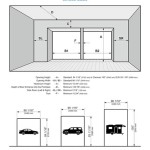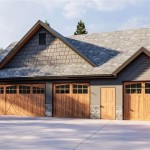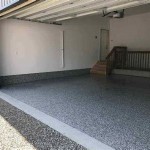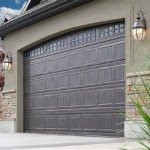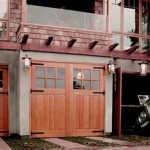Can You Paint A Metal Garage Door To Look Like Wooden Floor?
The desire to enhance the aesthetic appeal of a home is a common pursuit. One area often considered for improvement is the garage door. Metal garage doors, while durable and functional, can sometimes lack the visual warmth and character of natural wood. Consequently, homeowners may explore the possibility of transforming their metal garage door to mimic the appearance of a wooden floor, or in this case, a wooden door. This article will delve into the feasibility of this endeavor, outlining the necessary steps, materials, and techniques involved in achieving a convincing faux wood finish on a metal garage door.
The premise of painting a metal garage door to resemble wood hinges on understanding the principles of trompe-l'oeil, an art technique that uses realistic imagery to create the optical illusion that depicted objects exist in three dimensions. Applying this principle to a garage door requires careful planning, meticulous execution, and a keen eye for detail. Factors such as the existing color of the door, the desired wood grain pattern, and the type of paint used all play a crucial role in the final outcome.
Preparation is Paramount
Before embarking on the painting process, thorough preparation is essential. The success of the faux wood finish hinges on the condition of the metal surface. The first step involves cleaning the garage door to remove any dirt, grime, grease, or rust. A pressure washer can be used for this purpose, followed by a scrub with a mild detergent and water. It is imperative to allow the door to dry completely before proceeding to the next stage.
Once the door is clean and dry, inspect it for any signs of rust or damage. Rust spots should be treated with a wire brush or sandpaper to remove the corrosion. Any dents or imperfections can be filled with an automotive body filler, ensuring a smooth and even surface. After the filler has dried, sand it down until it is flush with the surrounding metal.
The subsequent step involves priming the garage door. A high-quality metal primer is crucial for ensuring proper adhesion of the paint and preventing rust from reappearing. Apply the primer evenly using a brush, roller, or spray gun, following the manufacturer's instructions. Allow the primer to dry completely before proceeding. The choice of primer color can influence the final wood tone, so consider a tinted primer that complements the desired wood finish.
Masking off any areas that should not be painted, such as windows, trim, or hardware, is also a critical part of the preparation process. Use painter's tape to create clean, sharp lines and protect these surfaces from accidental paint splatters.
Selecting the Right Materials
The choice of paint is paramount in achieving a realistic wood grain effect. Oil-based paints are generally more durable and weather-resistant than latex paints, making them a suitable option for exterior applications. However, oil-based paints require mineral spirits for cleanup and may have a stronger odor. Acrylic latex paints, on the other hand, are water-based, easier to clean up, and have lower VOC emissions. Regardless of the type of paint chosen, it is essential to select a high-quality exterior paint specifically designed for metal surfaces.
In addition to the base coat, several other supplies are necessary for creating the wood grain effect. These include a wood graining tool, which is a rubber rocker or comb designed to mimic the appearance of wood grain; artist's brushes, for adding fine details and highlights; and a variety of rags and sponges for blending and manipulating the paint. The selection of paint colors is also crucial. Typically, two to three shades of brown are used to create the desired wood tone, with a lighter shade for the base coat and darker shades for the graining and shading.
Consider using a gel stain instead of regular paint for the graining effect. Gel stains are thicker and more translucent, allowing for greater control over the wood grain pattern. They also tend to be more forgiving and easier to blend than paint, which is particularly beneficial for beginners.
Furthermore, a clear topcoat is recommended to protect the painted surface from the elements and enhance its durability. A clear coat with UV inhibitors will help prevent the paint from fading or cracking over time. Choose a topcoat that is compatible with the type of paint used for the base coat and wood grain effect.
Techniques for Creating the Faux Wood Grain
Once the preparation is complete and the materials are gathered, the actual painting process can begin. Apply the base coat of paint evenly over the primed garage door, using a brush, roller, or spray gun. Allow the base coat to dry completely according to the manufacturer's instructions. This base coat will serve as the foundation for the wood grain effect.
Next, apply a thin layer of the darker shade of paint or gel stain over a small section of the door. Using the wood graining tool, rock or drag it across the wet paint to create the desired wood grain pattern. Experiment with different techniques and angles to achieve a natural and varied look. Work in small sections to prevent the paint from drying before the graining effect can be applied.
After creating the wood grain pattern, use a dry rag or sponge to blend and soften the edges of the grain, creating a more realistic and textured appearance. Pay attention to the direction of the grain and vary the pressure applied to the rag or sponge to create subtle variations in the wood grain pattern.
For added realism, use artist's brushes to add fine details, such as knots, cracks, and highlights. These details can significantly enhance the overall appearance of the faux wood finish. Use a lighter shade of paint to create highlights and a darker shade to create shadows and cracks.
Repeat the process of applying paint, creating the wood grain pattern, and blending the edges until the entire garage door is covered. Step back periodically to assess the overall appearance and make any necessary adjustments. Remember to maintain a consistent direction for the wood grain pattern throughout the entire door.
Finally, apply a clear topcoat to protect the painted surface and enhance its durability. Apply the topcoat evenly, following the manufacturer's instructions. Allow the topcoat to dry completely before using the garage door.
The success of this project also relies on the overall aesthetic plan. Consider the architectural style of the house and the existing color scheme. Choose wood tones that complement the surroundings and enhance the overall curb appeal. Research different types of wood and wood grain patterns to find a look that appeals to your personal taste and matches the architectural style of your home. The level of detail and realism achieved will vary depending on the skill and patience of the painter. With careful planning, meticulous execution, and a keen eye for detail, it is possible to transform a metal garage door into a convincing replica of wood.
The implementation of these techniques aims to provide a visually appealing alternative to standard metal garage doors, offering homeowners a way to add warmth and character to their homes without the expense and maintenance associated with real wood.

How To Paint A Door Look Like Wood It S Easier Than You Think Average But Inspired

Faux Wood Door Gel Stain Diy How To Make Your Look Like

How To Paint A Garage Door Look Like Wood

Faux Wood Door Gel Stain Diy How To Make Your Look Like

Giani Wood Look For Garage Doors Full Demo

How To Paint A Door Look Like Wood 7 Shades Choose From

Diy Garage Door Makeover With Gel Stain Fresh Mommy Blog

How To Paint A Door Look Like Wood It S Easier Than You Think Average But Inspired

Diy Garage Door Makeover With Stain Domestically Speaking

Diy Garage Door Makeover With Stain Domestically Speaking
Related Posts

